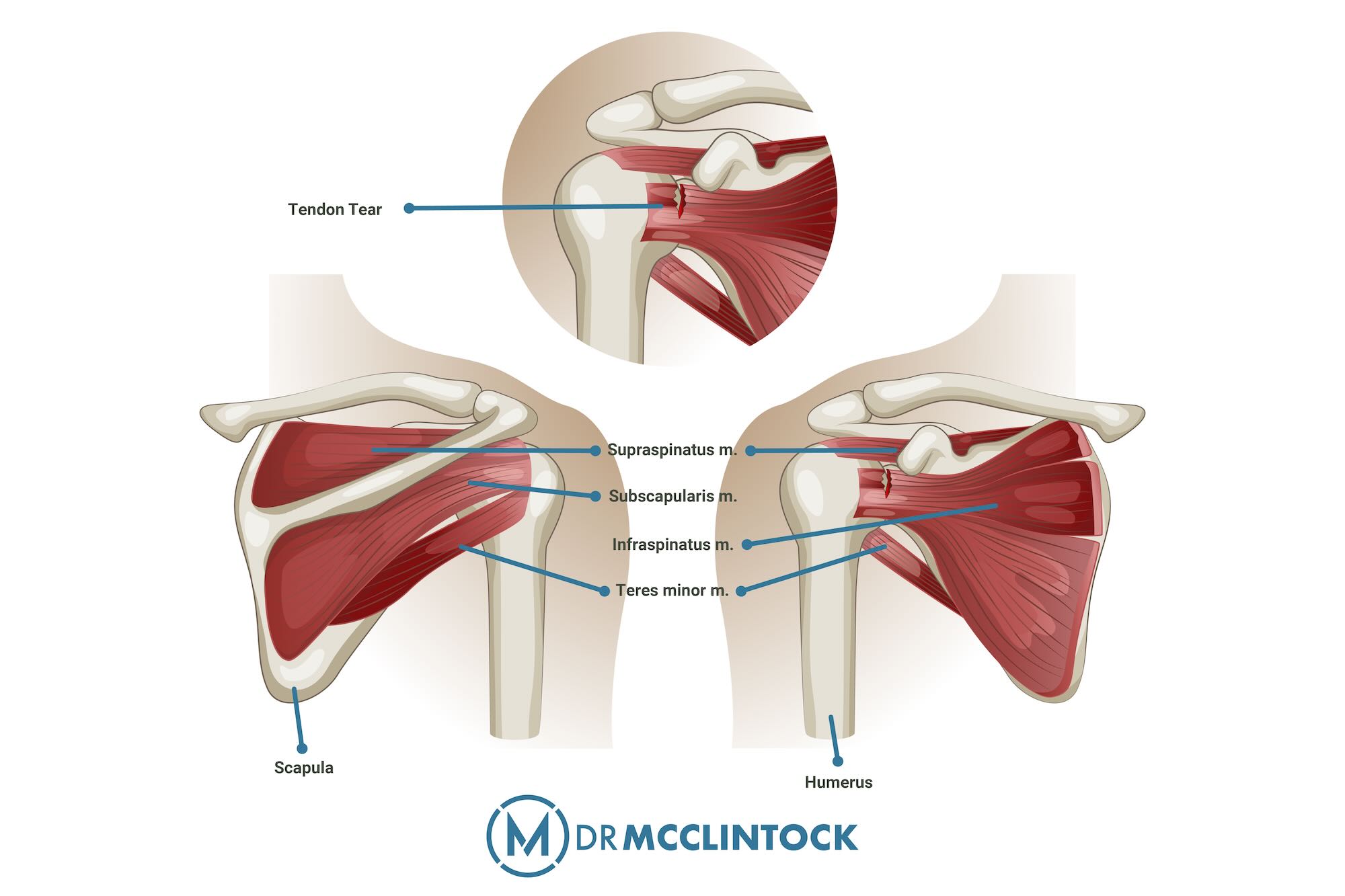Worried you might have a rotator cuff injury? This post shows you how to perform a basic “rotator cuff injury test at home”. Following these steps may help guide you to see if you need to consult an orthopedic surgeon.
Key Takeaways
- Early recognition of rotator cuff injury symptoms, such as shoulder pain, weakness, and limited range of motion, is crucial for preventing further damage and ensuring a quicker recovery.
- Home tests including the Drop Arm Test, Apley Scratch Test, and Lift-off Test can help identify potential rotator cuff injuries, but should be complemented by professional medical evaluation for accurate diagnosis.
- Non-surgical treatments like rest, physical therapy, pain medications, and PRP may be effective for many rotator cuff injuries, with surgery considered only for severe cases or when other treatments fail.
Recognizing Rotator Cuff Injury Symptoms
Early recognition of rotator cuff injuries is important for preventing further damage and ensuring a speedy recovery. The rotator cuff, consisting of four muscles and tendons that surround the shoulder joint, is vital for shoulder stability and movement. When these structures are compromised, a range of symptoms can emerge, signaling potential rotator cuff tears or other related issues.

One of the primary indicators of a rotator cuff injury is shoulder pain, often described as a deep ache localized in the shoulder area. This discomfort can intensify during specific activities, particularly those involving overhead movements. Imagine reaching for a bottle in the shower or trying to hang up clothes – these simple tasks can suddenly become challenging and painful. What’s more, the pain doesn’t always subside when you’re at rest. Many individuals with rotator cuff injuries report increased discomfort at night, which can significantly disrupt sleep patterns.
Beyond pain, rotator cuff injuries can manifest in other ways that impact your daily life. You might notice:
- A marked weakness in your affected arm, making it difficult to lift or reach for objects
- Limited range of motion, particularly when trying to rotate or lift your arm
- A crackling sensation, known as crepitus, when moving your shoulder
These symptoms can be telltale signs of a rotator cuff problem, potentially indicating rotator cuff disease, a torn rotator cuff, or torn rotator cuffs.
If you notice a combination of these symptoms, you’ll want to evaluate the possibility of a rotator cuff injury. Remember, early detection can make a world of difference in your recovery journey.
Home Tests for Rotator Cuff Injuries
Although a professional medical evaluation is indispensable, conducting home tests for rotator cuff injuries can offer initial insights into the condition of your shoulder. These tests are designed to assess the strength and functionality of your rotator cuff muscles and tendons, offering clues about potential issues. In this part, we’ll delve into three tests: the Drop Arm Test, the Apley Scratch Test, and the Lift-off Test. Each of these examinations targets different aspects of shoulder function, helping you gain a comprehensive understanding of your shoulder health.
Remember, these tests are meant to be a starting point – they can help you decide whether it’s time to seek professional help, but they’re not a substitute for a thorough medical evaluation.
Drop Arm Test
The Drop Arm Test is a simple yet effective way to assess the integrity of your rotator cuff, particularly the supraspinatus and infraspinatus tendons, which are connected to the upper arm bone. This test evaluates your ability to control arm movement and lower your arm in a controlled manner from a 90-degree angle. To perform this test, start by elevating your arm to a 90-degree angle from your body, parallel to the ground. Then, slowly attempt to lower your arm back to your side.
As you lower your arm, pay close attention to how it moves. If you can lower it smoothly and without pain, that’s a good sign. However, if your arm drops uncontrollably or you experience significant pain during the movement, it may indicate a possible tear in your rotator cuff. This uncontrolled dropping is particularly telling if you can’t lower your arm from the 90-degree position in a controlled manner.
Remember, while this test can provide valuable insights, it’s most effective at detecting larger tears in the rotator cuff. Smaller injuries might not be as apparent with this method, which is why it’s important to consider the results of multiple tests and any persistent symptoms you’re experiencing when getting a rotator cuff tear diagnosed.
Apley Scratch Test
The Apley Scratch Test is a versatile examination that assesses your shoulder’s flexibility and range of motion. This test is particularly useful for evaluating both your ability to internally and externally rotate your shoulder, as well as your capacity to reach behind your back. These movements are crucial for many daily activities, from putting on a jacket to fastening a bra, making this test a practical indicator of your shoulder’s functionality.
To perform the Apley Scratch Test, start by reaching over your shoulder with one hand, attempting to touch your opposite shoulder blade. This movement tests your shoulder’s ability to externally rotate and abduct, involving the arm bone in the process.
Next, reach behind your back with the same hand, trying to touch the lower corner of your opposite shoulder blade. This action assesses internal rotation and adduction. Pay attention to any pain, stiffness, or limitations in your range of motion during these movements.
If you find it difficult or impossible to reach certain areas, or if you experience significant discomfort, it could indicate a potential rotator cuff issue. Compare the affected shoulder with your healthy shoulder to gauge the difference in flexibility and pain levels.
This test is particularly valuable for identifying subtle changes in your shoulder’s range of motion that might not be apparent in your day-to-day activities.
Lift-off Test
The Lift-off Test is a specific examination designed to evaluate the integrity and strength of your subscapularis tendon, an essential component of your rotator cuff. This test is particularly useful because the subscapularis muscle plays a crucial role in internal rotation and stability of the shoulder joint. Any weakness or dysfunction in this area can significantly impact your shoulder’s overall performance and lead to further complications if left unaddressed.
To perform the Lift-off Test, follow these steps:
- Place the back of your hand on your lower back, as if you’re tucking in your shirt.
- Attempt to lift your hand away from your back without moving your elbow.
- Pay close attention to your ability to perform this movement and any pain or weakness you might experience.
If you find it difficult or impossible to lift your hand away from your back, or if you experience significant pain during the attempt, it could indicate a problem with your subscapularis tendon.
This test is particularly sensitive to subscapularis dysfunction, making it a valuable tool in your home assessment arsenal. However, remember that while this test can provide important clues about your shoulder’s condition, it’s just one piece of the puzzle. Combining the results of this test with other assessments and your overall symptom profile will give you a more comprehensive understanding of your shoulder health.
Evaluating Test Results
After performing these home tests, you might be wondering what your results mean and how to interpret them. It’s important to approach your self-assessment with a balanced perspective, understanding that while these tests can provide valuable insights, they are not definitive diagnoses. Persistent pain, noticeable weakness, or limited range of motion during any of these tests strongly suggest the need for a professional medical evaluation. These symptoms, especially when combined, suggest that there might be an underlying issue with your rotator cuff that requires attention.
Comprehending the implications of your home test results is vital for informed decision-making about your shoulder health. Here are some potential implications of different test results:
- If you struggled with the Drop Arm Test, experiencing an uncontrolled drop or significant pain, it could point to a potential tear in your supraspinatus or infraspinatus tendons.
- Difficulties with the Apley Scratch Test might indicate issues with shoulder flexibility and range of motion, which could be related to rotator cuff problems or other shoulder conditions.
- If the Lift-off Test proved challenging, it might suggest a problem with your subscapularis tendon.
However, it’s essential to remember that these tests are not infallible. Factors such as pain tolerance, overall fitness, and the specific nature of an injury can all influence the results. That’s why it’s vital to consider these test results along with your overall symptoms and daily experiences. If you’re unsure about your results or if your symptoms persist, don’t hesitate to consult with an orthopedic surgeon for a comprehensive evaluation.
Non-Surgical Treatment Options
The good news is that many cases of rotator cuff injuries can be effectively managed without the need for rotator cuff surgery. Non-surgical treatment options are often the first line of defense, especially for minor injuries or partial tears. One of the most fundamental approaches is rest and activity modification. Giving your shoulder a break from activities that exacerbate the pain can help reduce joint pain and swelling, particularly in cases of partial rotator cuff tears. This doesn’t mean complete immobilization, but rather a careful balance of rest and gentle movement to promote healing without further aggravating the injury. Some non-surgical treatment options for rotator cuff injuries include:
- Physical therapy
- Pain medication
- Steroid injections
- Platelet-rich plasma (PRP) injections
It’s important to consult with an orthopedic surgeon who specializes in shoulders to determine the best course of treatment for your specific injury.
In conjunction with rest, applying ice to the affected shoulder can be a simple yet effective way to manage pain and reduce swelling. Ice therapy is particularly beneficial in the acute phase of an injury or when you’re experiencing a flare-up of symptoms. Another cornerstone of non-surgical treatment is the use of nonsteroidal anti-inflammatory drugs (NSAIDs) such as ibuprofen or naproxen. These medications can help reduce inflammation and alleviate pain, making it easier for you to engage in other aspects of your treatment plan. However, it’s important to use these medications as directed and consult with a healthcare professional, especially if you need to use them for an extended period.
Physical therapy is perhaps one of the most critical components of non-surgical treatment. Working with a physical or occupational therapist can help you:
- Build strength and flexibility in your shoulder, arm, and back muscles
- Target your rotator cuff muscles with specific exercises
- Improve your range of motion
- Correct any imbalances that might be contributing to your injury
- Learn proper techniques for daily activities to prevent further strain on your shoulder
Remember, consistency is key when it comes to physical therapy – regular exercises and adherence to your therapist’s recommendations can significantly improve your outcomes.
While these conservative treatments can be highly effective for many people, it’s important to monitor your progress. If your shoulder pain persists despite these home treatments, you’ll want to seek a doctor’s advice for further evaluation and potentially more intensive treatment options.
When to See a Doctor
Even though home tests and conservative treatments are valuable in managing rotator cuff injuries, certain situations necessitate professional medical attention. One of the most urgent scenarios is when your shoulder joint appears visibly deformed after an accident or fall, possibly indicating an injured arm. This deformity could indicate a severe injury, such as a dislocation or a significant tear, which requires immediate medical intervention. Similarly, if you experience intense pain or find yourself unable to use your shoulder or move your arm away from your body, these are red flags that warrant urgent medical help. In such cases, don’t hesitate to seek emergency care, as prompt treatment can significantly impact your recovery and long-term shoulder function.
Beyond these acute situations, there are other signs that it’s time to schedule a doctor’s appointment. If you notice:
- Increasing pain
- Swelling
- Redness
- Warmth around your shoulder joint
These could be indicators of inflammation or infection that need professional evaluation. Additionally, if you find that the difficulty in moving your painful shoulder is progressively worsening, it’s essential to consult a healthcare provider. This gradual decline in function could suggest a developing problem that might benefit from early intervention. Another crucial reason to seek medical attention is when shoulder pain severely limits your daily activities or disrupts your sleep. Chronic pain that interferes with your quality of life deserves thorough investigation and targeted treatment.
During a doctor’s visit for your shoulder concerns, you can anticipate a comprehensive evaluation process. Your healthcare provider will likely start with a physical examination and a detailed discussion of your symptoms and medical history. Depending on their findings, they may recommend imaging tests to get a clearer picture of what’s happening inside your shoulder. Some common imaging tests include:
- X-rays, which can help visualize bone spurs or other potential causes of shoulder pain, although they won’t show a rotator cuff tear directly.
- Ultrasound, which allows for assessment of shoulder structures during movement and comparison between your affected and healthy shoulders.
- MRI, which provides a more detailed view of all shoulder structures and is particularly helpful in diagnosing rotator cuff injuries.
These diagnostic tools, combined with your doctor’s expertise, will guide the development of an appropriate treatment plan tailored to your specific condition.
Preventing Rotator Cuff Injuries
The saying, ‘an ounce of prevention is worth a pound of cure,’ is especially applicable to rotator cuff injuries. One of the most effective ways to protect your shoulders is by incorporating rotator cuff muscle and scapular strengthening exercises into your regular workout routine. These exercises help build the stability and resilience of your shoulder complex, reducing the risk of injury. Consider working with a physical therapist or certified fitness professional to develop a tailored exercise program that addresses your specific needs and any existing shoulder issues you may have. Some exercises to consider include:
- External rotation with resistance band
- Internal rotation with resistance band
- Scapular retractions
- Shoulder shrugs
- Shoulder blade squeezes
By regularly performing these exercises, you can strengthen your rotator cuff muscles and improve the stability of your shoulders, reducing the risk of injury.
Another important aspect of prevention involves being mindful of your daily activities and postures. Avoid repeated overhead arm positions that may cause shoulder pain. This is especially important if your job or hobbies involve frequent overhead movements. If you can’t avoid these positions entirely, take regular breaks and practice proper form to minimize stress on your rotator cuff. Additionally, pay attention to your sleeping habits. Avoid sleeping on your side with your arm stretched overhead or lying directly on your shoulder. These positions can put unnecessary strain on your rotator cuff tendons and contribute to shoulder impingement syndrome over time.
Maintaining good posture is another key factor in preventing rotator cuff injuries. Poor posture can alter your shoulder blade position and create conditions that lead to shoulder impingement syndrome. Here are some tips to help you maintain good posture:
- Sit and stand with your shoulders back and down, your chest open, and your head aligned over your spine.
- If you spend long hours at a desk, ensure your workstation is ergonomically set up to support good posture.
- Regular stretching and mobility exercises can also help counteract the effects of prolonged sitting or standing.
By following these tips, you can help prevent rotator cuff injuries and promote overall shoulder health.
By incorporating these preventive measures into your daily life, you can significantly reduce your risk of rotator cuff injuries and maintain healthy, pain-free shoulders for years to come.
Summary
Remember, while these rotator cuff tests at home can serve as a guide, they’re just the first step. We’ve discussed the importance of knowing when to seek professional help and the various non-surgical treatment options available. From rest and ice therapy to physical therapy and lifestyle adjustments, there are numerous ways to address rotator cuff problems before considering surgical interventions. Perhaps most importantly, we’ve emphasized the power of prevention – strengthening exercises, mindful movements, and good posture can go a long way in safeguarding your shoulders. As you move forward, listen to your body, stay active within your limits, and don’t hesitate to seek help when needed.
Frequently Asked Questions
How long does it typically take for a rotator cuff injury to heal with non-surgical treatment?
The healing time for a rotator cuff injury can vary, with minor strains or partial tears improving within a few weeks to months, and more significant tears or chronic conditions taking several months to show substantial improvement. It’s crucial to follow your healthcare provider’s recommendations and be patient with the healing process.
Can I still exercise if I suspect I have a rotator cuff injury?
Yes, you can still exercise if you suspect a rotator cuff injury, but it’s crucial to consult with a healthcare professional or physical therapist for appropriate exercises and to avoid activities that worsen the pain. Always prioritize professional guidance to prevent further damage to your shoulder.
Are there any specific occupations that put people at higher risk for rotator cuff injuries?
Certain occupations that involve repetitive overhead motions or heavy lifting, such as painting, carpentry, athletics (especially swimming and baseball), hairstyling, and warehouse work, can increase the risk of rotator cuff injuries. It’s important to practice proper form, take regular breaks, and perform preventive exercises to lower the risk.
Can rotator cuff injuries heal on their own without any treatment?
No, most rotator cuff injuries require some form of treatment for proper healing. Ignoring the injury or hoping it will heal on its own can lead to chronic pain, weakness, and potentially more severe tears, so it’s best to seek professional advice for persistent shoulder issues.
Is surgery always necessary for a torn rotator cuff?
Surgery is not always necessary for a torn rotator cuff. The decision depends on factors such as the size and location of the tear, age, activity level, and response to conservative treatments. Non-surgical options like physical therapy and medication may be sufficient for partial tears, while larger tears in younger or very active individuals may require surgery for the best results.





